
15th July 2001
News/Comment|
Editorial/Opinion| Plus|
Business| Sports|

Image and personality on TV
Image means everything to people today. Every- body is concerned about their overall image; how they look, how they dress, how they hold themselves and ultimately through it all how they project themselves.
In this image conscious world where etiquette, grooming and personality development are becoming important parts of everyday life we take a look at how television presenters, the focus of thousands of people's attention, handle image. How do they ensure that their viewers don't change the channel on them?
Oops, a blooper!
"If you can read the news live to an audience as diverse as Sri Lankans and take the criticism as well as the praise then I think that you can handle anything," says Chevaan Daniels, the face we've got used to seeing on MTV news.Chevaan who chose to venture into this field because he wanted to gain
experience, started his broadcasting career with little knowledge in the
ways of television presenting. After being spotted 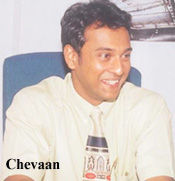 giving
a speech at a function he was asked to carry out a voice test and subsequently
started reading the news for Yes F.M. without any formal training. After
just a year reading for the radio station, at age nineteen he found himself
a part time presenter for MTV.
giving
a speech at a function he was asked to carry out a voice test and subsequently
started reading the news for Yes F.M. without any formal training. After
just a year reading for the radio station, at age nineteen he found himself
a part time presenter for MTV.
Chevaan, certain that the experiences he has had reading news have helped him gain self-confidence - an asset in all aspects of his life - says that obviously, the most important aspect in television is the visual. Great emphasis is placed on the dress and appearance of the presenter. To come across as smart and pleasant is essential but there is also a need to hold the audiences' attention by not being too dull or boring.
"50% of reading the news is body language, using your eyes, head and arms are all very important." However, he adds that there is the need to strike the right balance so that you are not distracting the viewer from what you are saying but are still helping to convey the news story that is being told.
"Initially I put on my own make-up but it was so bad I looked as if I had been embalmed, they do it for me now," commented Chevaan, stressing that dress, make-up and grooming are all very important in this visual medium. Reading the news at night, Chevaan is required to dress according to the expectations of his target audience. To wear formal clothes, a shirt, tie and blazer is considered to be the most appropriate when trying to project the correct image for the programme and the station as a whole.
And what about on-screen image bloopers? "Nearly every bad thing that could happen has happened to me," he said with a smile spreading across his face. "Once I even got caught picking my nose. I thought no-one was watching as there was a video clip on but then realized the cameras had come back onto me!"
Body choreography
Kumar de Silva who's been in the television business for the
past 16 years, having started with the programme Bonsoir in 1986 has experienced
first hand the evolving trends of image. According to him total image on
television has undergone many changes in the 22 years of television in
Sri Lanka. Says Kumar, "When it first started, being a new area, there
were naturally only very few presenters. Thus at the time presenters were
larger than life figures and we lived that image both on camera and 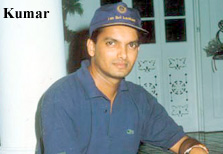 off."
off."
However today with so many channels, a presenter is no longer a larger than life figure. "It's very much like just another job, albeit maybe one that comes with a bit more glamour. Now we do not put on an image as we used to, but instead maintain a very authentic, 'real' appearance."
He personally feels that as far as 'on camera' presence is concerned, visual image is very important. "Now that's where personal grooming becomes important. When choosing clothes one obviously can't wear things that are too jarring because then you would look like a pandal."
To break the monotony Kumar says that sometimes he dresses in accordance with the theme of the programme he presents. When presenting Fan Club he maintains the 'hip' look, where as in contrast when it's a programme with a religious theme, his dress code is full white. "You should suit the environment you are in and the one you create."
He says with a laugh that a personal kink of his, which he developed rather recently is to wear only plain colours. That meant putting away all the dots, spots and stripes he previously owned. Speaking on colours he maintains that colours do make a difference. "Black doesn't really suit us, although many seem to think it does. However flashy colours like bright yellow and oranges are not for TV. The colours belonging to the beige, blue, green family really suit our skin and look good on TV."
Just as much as grooming is important, a presenter's knowledge on the subject he is presenting is important as well, or even more so because that's the very base of the programme, says Kumar who feels that a presenter must not only be well-read, but well-informed and well-prepared and should handle subjects he is very familiar with. "What's the point if the person on TV looks really great but just doesn't know what he is talking about?"
Says Kumar, "People who wouldn't give me a second glance when I'm out on the road, listen to and look at me as a presenter. In this position where I command their attention I need to give them both content and a presentable visual, which contributes to an equally balanced image."
Yet another point that a presenter needs to be conscious about when on television is body language. The way he sees it, that too contributes to the overall image. "Body language should be used to enhance the programme rather than to take away from it."
Giving some examples he touches on the point that if a presenter waves his hands about, it is a distraction, where- as perfect eye communication adds to the overall effect. "When you're seated in front of a table, everything's fine, but on a chair or a couch, the placing of your legs is most important. Movement has to be natural and you've got to be careful not to kick your interviewee. So really your entire body needs to be choreographed." But for him standing is the worst possible postion because according to him, "Your hands just hang down at your sides and with clip-on mikes you can't even hold on to a mike anymore. So what you're going to do with your hands must be carefully thought out."
How confident and assertive the presenter is comes through body language, says Kumar. When a person looks around, fidgets, does not look a person directly in the eye, he is nervous and ill at ease.
Kumar handles Fan Club, Meeting Point, a business talk show, a discussion on Buddhism and Star Gallery, a bilingual chat show.
Where a presenter's image is concerned Kumar feels that a person's got to possess some attributes before going in for a job on TV, but overall image can be worked on later. However one can't walk in for the basic interview dressed in a slovenly manner - he or she would never get the job. Even for him, although he's well-informed, to begin with the whole process of building an image was a learning process. "No one is perfect," he says adding, "I still learn with every interview."
Although Kumar works for two channels he has no problems where image is concerned. 'Image' for him is personal, his own which he has developed over the years and that seems to suit everyone just fine.
Clearly relaxed
As a presenter for YA TV Tharindi Fonseka is very conscious of how she appears on camera. "We need to be serious in front of the camera when reporting the issues so that the message is clear but must also be relaxed or you could lose the viewers' attention."
Her four years experience in television presenting has taught Tharindi
just how important image is. "Radio is very different from television.
In radio you are only concentrating on the words, in television 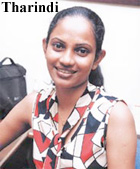 people
are not only listening carefully, but they are watching carefully as well."
people
are not only listening carefully, but they are watching carefully as well."
In keeping with the trendy outlook of the programme, she usually opts for quite casual plain coloured clothes. Says Tharindi, "There are no direct dress codes, we are just told to wear smart-casual. We are allowed to wear whatever we want really, but there are limits."
Fancy or crowded designs are not really advisable as they can distract the audience from the more important aspect of the programme's content.
The appearance of the presenter is one of the most essential aspects in creating a successful programme. To strike the right note, in accordance with the people that you are trying to reach, is of the utmost importance.
Reflective
Chamuditha Samarawickrema the presenter of popular programme Jana Handa says that where his image was concerned he wanted to do something special and so the image that he projects is one that reflects the views of the people. "I strive to project a very neutral image as mediator of the programme, although some people tend to think otherwise."
The most important point for a television presenter to remember, according
to him is that they're not stars who 'act', rather they are presenters
who present a real situation and body language must reflect 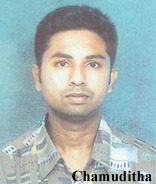 that
image.
that
image.
Says Chamuditha, "Body language counts and that's something I've learned having attended courses and observing other programmes. Your body language must reflect what you are saying. It is when they come out at odds with each other, that the image you present becomes confusing."
"Your confidence comes through your body language but feeling totally confident is something you never really learn. It just grows as you grow into your role as a presenter," he says. Even today he feels that he is still not 100% confident.
Visual image must be complemented with substance and that must come from the presenter. "Knowledge of one's subject matter is a big part of image. You must have that, the rest can be polished up."
Having started off his career in 1996 as news co-ordinator, he says that with every new programme he presents, his overall image grows and as he puts it, "I keep on learning."
Smart and natural
Says designer/choreographer Senaka de Silva, "On television overall image is everything since it is everything to do with the visual image. Thus people who go in for the job must be well-informed and they also need to be presentable."
According to him image is hair, face, features, clothing and the personality you project through it. "Where clothes for a presenter are concerned, colours are very important. In this case it's not just what suits the presenter, but also what colours show up best on camera under lights must be taken into consideration."
As for make-up it's natural, to cover up your flaws and yet enhance your features. Make- up must not be plastered on, he says, for this makes the person look artificial. As presenters they are not doing something artificial so why should they look it? The way a person animates the programme and moves is a part of body language and sometimes needs to be choreographed.
"Smart and natural is the order of the day," says Senaka adding that artficiality shows up on TV. "A presenter is the centre of attention, but they must remember that they are just the medium, the substance is what makes the programme."
He stresses that although things are getting better, we still lag behind
where presenting a good visual image is concerned. "There is a great need
for proper training. Image is something that can be taught - that's what
we do with models. These methods of training just need to be geared towards
television presenters as well. This is an important field and we must give
our attention to it."
Creative cookery
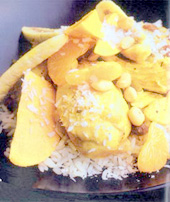 Raj
Chicken and Mango Curry
Raj
Chicken and Mango Curry
2 onions chopped
1 tbsp sunflower or vegetable oil
2 tsp curry powder
2 tbsp curry paste
1level tbsp flour
2 apples, peeled, cored and chopped
1 tbsp mango chutney
1 small cooked chicken, meat only
500 ml chicken stock
11/2 tbsp sultanas
To serve:
Mango slices, salted cashew nuts
In a wide saucepan, gently heat the onions until they are soft. Next
stir in the curry powder and cook for a further minute. Add the curry paste
and gently fry. Next stir in the flour and cook for about 30 seconds. Add
the apple, chutney and chicken and stir through until well coated. Next
add the stock and throw in the sultanas, bring to a low boil and season.
Allow to splutter away for a good 30 minutes until the apple is soft
and the liquid has infused with the curry colour. Taste and add more salt
if necessary. Finally add mango slices and cashewnuts when serving.
Mango Lassi
Whizz up 3 small, ripe chilled mangoes with about 5tbsp of low-fat chilled yoghurt and 4 tbsp of iced water.For an alternative, make a lime-sugar syrup by heating 2 tbsp of caster
sugar with 3 tbsp of lime juice and then leave it to go cold. Use this
instead of the water in the lassi.
Mango Toast
Smother toast with sweet mango chutney and top with cheddar cheese and grill until bubblingChilli Mango Prawn Salad
Ingredients1 tbsp ground nut or mustard oil
2 tsp mustard seeds
16 cooked tiger prawns peeled with tail tips left on
1 large very firm mango with green skin peeled
1 medium cucumber
2 limes and 1/2 a lemon juiced
1tbsp sugar
1/2 a chilli, finely shredded
1/2 small red onion finely sliced
Good handful coriander leaves
2 tbsp grated fresh coconut
For the fenugreek and chilli salt
1/2 tbsp fenugreek seeds
2 tbsp sea salt
11/2 tsp mild chilli powder
Method: Heat the oil at a side of the frying pan, and add the mustard seeds. Fry for a few seconds until you see them start to pop. Remove from heat, throw in the prawns and coat with the mustard seeds and oil, then leave to cool. Next, grate the mango and cucumber.
Mix the citrus juices with the sugar to dissolve , add the chilli and leave to sit while you prepare the fenugreek and chilli salt. In a mortar or spice grinder, pound the seeds until crushed, then work in the salt and chilli powder to produce a fine, red crumb-like mixture. Then work through a teaspoon of oil to bring out the red chilli colour.
Finally, toss the shredded mango, cucumber and coriander with the sweet
citrus dressing and the onion and pile onto plates or bowls, interspersing
the layers with the mustard seed prawns. Sprinkle very lightly with the
chilli, fenugreek salt and shredded coconut and serve.
Pawpaw ice-cream
Method: Cut a small, peeled and seeded pawpaw into large pieces; place on an oven tray. Cover; freeze. Blend or process frozen pawpaw with 1 tablespoon honey and 3 teaspoons vanilla essence. With motor operating, gradually add 1 X 300ml carton cream until mixture is thick and smooth. Serve immediately, or spoon mixture into a loaf pan. Cover; freeze until required. Serve small scoops of ice-cream over extra pawpaw slices.Coronation chicken
• 3 whole chicken breasts• 4 cups water
• Peppercorns
• 1 small bay leaf or 1 teaspoon dried tarragon
• 1 small onion, sliced
• Fresh salad greens
• Finely sliced mango and mint leaves to garnish
Curry mayonnaise
• 1 tbsp oil
• 1 small onion, finely chopped
• 1 small clove garlic, crushed
• 1 tabsp curry powder
• 2 tsp tomato paste
• 2 slices lemon
• salt and freshly ground pepper
• 2 tblsp mango chutney
• 1 1/4 cups homemade mayonnaise
• 2-3 tblsp cream
Method: Step 1 Halve the chicken breasts. In a shallow pan or in a wide saucepan, bring to the boil lightly salted water, peppercorns, bay leaf (or dried tarragon) and onion. Add the halved chicken breasts, cover and reduce heat. Poach for 8-10 minutes. Turn off heat and allow chicken to cool in stock.
Step 2 To make curry mayonnaise, heat oil in a small pan, add onion and garlic and saute gently until onion is transparent. Add curry powder and cook, stirring for a few more minutes. Stir in tomato paste. Add lemon slices and salt and pepper and cook gently for 3 minutes more. Cool and remove lemon slices. When cold, add chutney, mayonnaise and cream, mix well. Taste and add more seasoning if needed. If mayonnaise sauce is too thick dilute with a little warm water.
Step 3 Cut poached chicken into large pieces. Place in a large
shallow bowl and add half the curry mayonnaise, fold through gently to
mix and leave for an hour or so for flavours to develop. To serve, arrange
salad greens on a platter, top with chicken pieces and spoon over a little
more curry mayonnaise. Top with slivers of mango and fresh mint leaves
if desired. Serves 6-8.
Be a winner
Nelun Herath writes on the power of a positive personalityIt was Nelson Mandela who in his autobiography 'Long Walk to Freedom' said that a man could walk into a room full of strangers and command attention while also being able to walk into a room full of strangers and not be noticed. What then is the difference?
Why is it that some people carry with them an air of pleasant command, an air of warmth and friendliness (even though not as gregarious as an extreme extrovert, while others are withdrawn and shy? What is the difference? Why is it that some have the knack of attracting so much admiration, so much positive attention and so many friends and acquaintances while some others may even have a problem of making two friends at a social gathering? What is the difference?
Why is it that some out of a group with similar or identical requisites are considered assets to any organization while some others make no difference?
In short, why is it that some seem to have it all -to be in total command of themselves, their private and professional lives? Research down the ages has shown that the difference, is that some people are able to bring out the best in themselves, while some others take what comes and cope with it if they can or let it ruin them if they can't.
Some people are certainly born with dynamism, with confidence but there are also those who acquire these qualities by themselves and have become tremendously successful.
It is no secret that nothing or no one is ever perfect but there are people who work towards being almost perfect - they work hard - and they are the people who win in the end.
No matter how confident, dynamic and successful we consider ourselves all of us can, must and should benefit from any tool that is available for personal growth. It is only when we use it that we will be in a position to enjoy the joy of personal growth.
Take the case of Ranjan who believed that some people were born to be successful, some to be mediocre, to live mediocre lives and others to have mediocre successes. He also believed that some were born to fail. This belief is what should be changed because people who carry this belief are a danger to themselves. They are afraid to open the doors to discovering themselves, they are afraid to venture deep within, they are afraid to be the best, they are afraid to try, they are afraid of success.
Psychologists have taught us that the first 5-7 years of a child's life are the most important - this is called the foundation period. The various inputs to a child during this period especially by the parents contribute tremendously to the type of personality the child develops. This is in addition to the genes and temperaments he/she acquires. But one thing is for sure, each individual is born with so much potential that it is indeed a calamity if this goes untapped.
Parents are also human - and are not infallible. Most parents of today are more aware and more concerned about the psychological development of their offspring. They know that using the cane on children can lead to drastic consequences. Most parents are aware of the advantages of praise, appreciation and recognition and there certainly is more interest in character development than any other generation before.
Let us be practical, children have the knack of making parents run up the wall at times and it seems natural that parents being human, may say things that cause harm, and these may have an impact on a child's personality. These may sadly be long term impressions. During the period of growing from childhood to adulthood, a human being has many inputs - some positive and some negative. It is the negative inputs that cause little 'dents' in a 'meant-to-be' dynamic and confident personality. No one is immune from these.
And so we live ..........
So we grow up learning all the while how to react, how to cope and how
to live. We then get used to ourselves, we get used to being who we are,
we get used to living the way we do, not realizing that we have tremendous
potential within us.
Looking inwards
What constitutes a dynamic personality?
Does a dynamic personality mean only acquiring as many academic certificates as possible? Does it mean having the most expensive wardrobe? Does it mean enjoying the best social evenings? Does it mean heavy bank balances? The answer is NO.
A dynamic and confident personality is someone we enjoy being with, enjoy talking to, enjoy learning from, enjoy listening to, enjoy watching. He or she is dependable, is committed, is motivated, enjoys taking challenges, enjoys taking the initiative, is confident of what he/she does, is analytical, positive and has a high regard for him or herself.
Let us look at ourselves{tc "Let us look at ourselves"}
Let us consider the example of posture. If we feel defeated inside of us, if we feel worthless, if we feel shy, this is projected through our posture. We tend to hunch. To the outside world, a person who hunches projects a negative personality. So how will the world react to a person who projects a negative personality? Give this a thought. History and research has also shown us that the world reacts well to a positive personality, the world respects a positive personality, the world loves a positive personality
The honest realisation and acceptance that we need to keep growing, that we need to keep learning is one of the key ingredients to growing in confidence and dynamism.







Return to Mirror Magazine Contents
![]()
Front Page| News/Comment| Editorial/Opinion| Plus| Business| Sports| Mirror Magazine
Please send your comments and suggestions on this web site to

